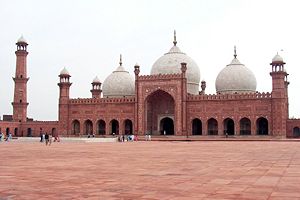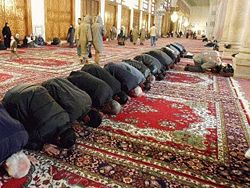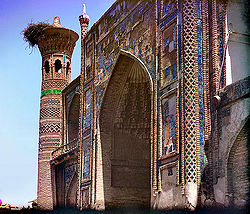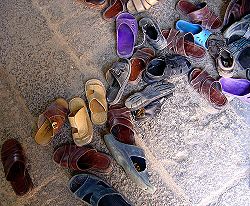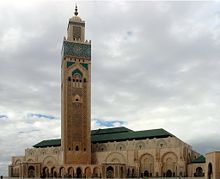Mosque
A mosque is a place of worship for followers of the Islamic faith. Muslims all over the world often refer to the mosque by its name in Arabic, masjid (pl. masajid) (Arabic: مسجد — pronounced: /mas.ˈɡʲid/ or /mas.ˈʤid/). The Arabic word masjid means temple or place of worship and comes from the Arabic root sajada (root "s-j-d," meaning to bow or kneel) which means he worshipped in reference to the prostrations performed during Islamic prayers.[1] The word mosque in English is used to represent all types of buildings dedicated for Islamic worship, although there is a distinction in Arabic between the smaller, privately-owned mosque and the larger, "collective" mosque (masjid jami) (Arabic: جامع), which has more community and social amenities.[2]
Mosques have evolved significantly from the open-air spaces that were the Quba Mosque and Masjid al-Nabawi in the seventh century. Today, most mosques have elaborate domes, minarets, and prayer halls.[3] At one time mosques could only be found in the Middle East, but now one can find mosques on all six inhabited continents where Muslim communities exist. The mosque is, and has always been, the center of the Muslim community. For Muslims, they are not only places to worship and pray; they are also places to learn about Islam and meet other Muslims.[2] On many occasions, places of worship of other faiths such as synagogues or churches were converted into mosques.
History
Although grand entryways and tall towers, or minarets, are associated closely with mosques, they originally lacked these elaborate features. The first three mosques were very simple open spaces on the Arabian Peninsula, but since that time over one thousand years ago, mosques have evolved to adapt to cultures and environments on all parts of the globe.
The first mosques
The first mosque in the world is sometimes considered to be the area around the Ka'bah in Mecca, Saudi Arabia, now known as the Masjid al-Haram, or Sacred Mosque.[4] Since as early as 638, the Masjid Al Haram has been expanded on several occasions to accommodate the increasing number of Muslims who either live in the area or make the annual Hajj, or pilgrimage, to Mecca.[5] Others regard the first mosque in the world to be the Quba Mosque, or Masjid al-Quba, in Medina (then named Yathrib) since it was the first mosque built by the Islamic prophet Muhammad. The first thing Muhammad did upon arriving with his followers outside Medina after the emigration from Mecca in 622 was build the Quba Mosque.[6] Muslims believe he stayed at the Quba Mosque for three days before moving on to the rest of Medina.[7]
Just days after beginning work on the Quba Mosque, Muhammad went on to establish another mosque in Medina, which is now known as the Masjid al-Nabawi, or the Prophet's Mosque. The location of the mosque was declared as such after it hosted Muhammad's first Friday prayer. Following its establishment, the Masjid al-Nabawi continued to introduce some of the practices that are now considered common in today's mosques. For example, the adhan, or call to prayer, was developed in the form still used in mosques today. The Masjid al-Nabawi was built with a large courtyard, a motif common among mosques built since then. Muhammad would stand up at one end of the arcade to preach. Later on, he would develop a three-step pulpit as a platform from which he would give sermons.[7] The pulpit, now known as a minbar, is still a common feature of mosques.
Today, the Masjid al-Haram in Mecca and the Masjid al-Nabawi in Medina are considered the two holiest sites in Islam.[8] The Masjid al-Haram today has a large courtyard that surrounds the Ka'bah and walls that form the edge of the structure and a separation from the city of Mecca.
Diffusion and evolution
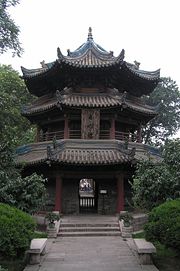
Mosques were built outside the Arabian Peninsula as Muslims moved to other parts of the world. Egypt became occupied by Muslim Arabs as early as 640,[9] and since then so many mosques have appeared throughout the country that its capital city, Cairo, has acquired the nickname of city of a thousand minarets. Egyptian mosques vary in amenities, as some have Islamic schools (madrassas) while others have hospitals or tombs.[10] Mosques in Sicily and Spain do not reflect the architecture of Visigoth predecessors, but instead reflect the architecture introduced by the Muslim Moors.[11]
The first Chinese mosque was established in the eighth century in Xi'an. The Great Mosque of Xi'an, whose current building dates from the eighteenth century, does not replicate many of the features often associated with traditional mosques. Instead, it follows traditional Chinese architecture. Mosques in western China incorporate more of the elements seen in mosques in other parts of the world. Western Chinese mosques were more likely to incorporate minarets and domes while eastern Chinese mosques were more likely to look like pagodas.[12] Mosques diffused into India during the reign of the Mughal empire in the sixteenth and seventeenth centuries. The Mughals brought their own form of architecture that included pointed, onion-shaped domes, as seen in Delhi's Jama Masjid.[13]
Mosques first arrived in the Ottoman Empire (mostly present-day Turkey) during the eleventh century, when many of the Turks in the region began to convert to Islam. Several of the first mosques in the Ottoman Empire, such as the Hagia Sophia in present-day Istanbul, were originally churches or cathedrals in the Byzantine Empire. The Ottomans created their own design of mosques, which included large central domes, multiple minarets, and open façades. The Ottoman style of mosques usually included elaborate columns, aisles, and high ceilings in the interior, while incorporating traditional elements, such as the mihrab.[14] Today, Turkey is still home to many mosques that display this Ottoman style of architecture.
Mosques gradually diffused to different parts of Europe, but the most rapid growth in the number of mosques has occurred within the past century as more Muslims have migrated to the continent. Major European cities, such as Rome, London, and Munich, are home to mosques that feature traditional domes and minarets. These large mosques in urban centers are supposed to serve as community and social centers for a large group of Muslims that occupy the region. However, one can still find smaller mosques in more suburban and rural regions throughout Europe where Muslims populate.[15] Mosques first appeared in the United States in the early twentieth century. However, as more immigrants continue to arrive in the country, especially from South Asia, the number of American mosques is increasing faster than ever before. While only two percent of the country's mosques appeared in the United States before 1950, eighty-seven percent of American mosques were founded after 1970 and fifty percent of American mosques founded after 1980.[16]
Mosques as focal points
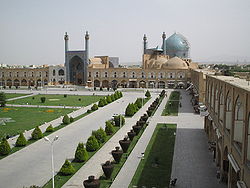
Many Muslim rulers after the death of the Islamic prophet Muhammad, emulating him, established their domains by first building a mosque. In the same way Mecca and Medina are built around the Masjid al-Haram and the Masjid al-Nabawi, Karbala, in present-day Iraq, was built around the Shi'ite Imam Hussain Shrine. Isfahan, Iran is especially notable for its use of mosques to form the center of the city. In the eighth century, a mosque was established within the city which three centuries later was described by theologian and philosopher Naser Khosrow as "a magnificent Friday Mosque built in the city center."[17] At the dawn of the seventeenth century, Shah Abbas I of the Safavid Dynasty led an effort to establish Isfahan as one of the largest and most beautiful cities in the world. As part of his plan, he ordered the building of Shah Mosque and Sheikh Lotf Allah Mosque which border Isfahan's Naghsh-i Jahan Square, which, as one of the largest city squares in the world, hosted sports and trade.[18]
Mosques built more recently, especially in countries where Muslims are not the majority, tend to be away from the center of major cities. Nevertheless, even a mosque in a less densely populated area often influences Muslims to relocate their homes and businesses so they are close to the mosque. Thus, mosques form the focal points of Muslim communities, even if they do not form the center of the entire community as a whole. In the United States, the growth in the number of mosques and congregants in suburbs is much greater than that in densely urban areas.[19]
Etymology of the word
Mosques were known to the English-speaking world well before the word to describe them was established. The Mezquita of Cordoba was one of the first mosques to attract Western attention; its name is simply one of many possible European transliterations for the Arabic masjid, or place of worship. However, in the fifteenth, sixteenth, and seventeenth centuries, variations of the word began to be used. Moseak, muskey, moschy, and mos'keh were just some of the variations that came into use until it was decided that mosquee, imitating Middle French, Italian, and Old Spanish, would become the standard. In the early eighteenth century, the modern spelling became the most popular and standard spelling of the word.[20]
Functions
The primary purpose of mosques is to serve as places of worship for Muslims. However, mosques today often host classes and programs that educate Muslims about their faith or allow Muslims to socialize with each other.
Prayers
All adult Muslims are required to offer prayer, or salat, at least five times each day. Although some smaller mosques with smaller congregations will offer only a few prayers, most mosques offer all five required prayers daily: before sunrise (fajr), at midday (dhuhr), in the afternoon (asr), after sunset (maghrib), and in the evening (isha'a). Muslims are not required to offer prayer inside a mosque, but according to hadith, offering prayer in congregation at a mosque is considered more virtuous than offering prayer alone.[21]
In addition to holding the five obligatory daily prayers, mosques hold jumuah prayers, or Friday prayers, which replace the midday prayer as the second required prayer on Fridays. While the ordinary daily prayers can be performed at any location, it is required that all adult men attend Friday prayers at the mosque.[2]
A funeral prayer, or salat ul-janazah, is held for a deceased Muslim at the mosque, with all congregants present, including the imam, participating. Unlike with the daily prayers, the funeral prayers are normally held outdoors in a courtyard or square close to the mosque.[22] During solar eclipses, mosques will host another special prayer called salat ul-kusuf.[23]
There are two large holidays, or eids, in the Islamic calendar: Eid ul-Fitr and Eid ul-Adha. On both of these days, there are special prayers held at mosques in the morning. The eid prayers are supposed to be offered in large groups, and so larger mosques will normally host eid prayers for their congregants as well as the congregants of smaller local mosques. Some mosques will even rent convention centers or other large public buildings to hold the large number of Muslims who attend the eid prayers. Mosques, especially those in countries where Muslims are the majority, will also host eid prayers outside in courtyards or town squares.[24]
Ramadan events
Islam's holiest month, Ramadan, is observed through many events. As Muslims must fast during the day during Ramadan, mosques will host iftar (break-fast) dinners after sunset and the fourth required prayer of the day, maghrib. Food is provided, at least in part, by members of the community, thereby creating nightly potluck dinners. Because of the community contribution necessary to serve iftar dinners, mosques with smaller congregations may not be able to host the iftar dinners daily. Some mosques will also hold suhoor meals before dawn to congregants attending the first required prayer of the day, fajr. As with iftar dinners, the food for suhoor is usually provided by congregants, although able mosques may provide food instead. Mosques will often invite poorer members of the Muslim community to share in beginning and breaking the fasts as providing charity during Ramadan in Islam is especially honorable.[25]
Following the fifth and final required prayer of the day, isha, special, optional tarawih prayers are offered in larger Sunni mosques. Shi'a mosques, however, do not observe tarawih prayers. During each night of prayers, which can last for up to two hours each night, a member of the community who has memorized the entire Qur’an will recite a segment of the book.[2] During the last ten days of Ramadan, larger mosques will host all-night programs to observe Laylat al-Qadr, the night Muslims believe the Islamic prophet Muhammad first began to receive the Qur'an. [2] On that night, between sunset and sunrise, mosques will employ speakers to educate congregants in attendance about Islam. Meals are usually provided by mosques or the community periodically throughout the night.
During the last ten days of Ramadan, larger mosques within the Muslim community will host i'tikaf, a practice in which at least one Muslim man from the community must participate. Muslims performing i'tikaf are required to stay within the mosque for ten consecutive days, often in worship or learning about Islam. As a result, the rest of the Muslim community is responsible for providing the participants with food, drinks, and whatever else they need during their stay.[2]
Charity
The third of Five Pillars of Islam states that Muslims are required to give approximately one-fortieth of their wealth to charity as zakat. Since mosques form the center of Muslim communities, they are where Muslims go to both give zakat and, if necessary, collect zakat. Prior to the holiday of Eid ul-Fitr, mosques also collect a special zakat that is supposed to assist in helping poor Muslims attend the prayers and celebrations associated with the holiday.[26]
Education
Another primary function of a mosque is to house educational facilities. Some mosques, especially those in countries where state-funded Islamic schools are not present, will have full-time schools that teach both Islamic and general knowledge. These full-time schools normally have students in elementary school and middle school, although there are also a few full-time schools available to high school students. Most mosques will also have part-time schools, either on the weekends or in the evenings. Whereas full-time schools are meant for children who depend on the mosque to provide an Islamic education as well as a general education, weekend and nightly schools are meant to provide only Islamic education for students of all ages, young and old. Some mosques, however, will also provide general educational help to Muslim students as a way of bringing young Muslims closer to the mosque. The subjects at the Islamic evening and weekend classes vary. Qur'an reading and Arabic are commonly found at mosques that are located in countries where Arabic is not widely spoken. Classes for new Muslims about the basics of Islam are also common, especially in Europe and the United States, where it is the fasting-growing religion.[27] Mosques will also go into more depth about Islam by providing congregants with classes on Islamic jurisprudence. Madrassas are also available for Muslims to study 'alim to become Islamic scholars or imam. However, as their primary purpose is not to serve as a place of worship or community center, madrassas are normally separate from neighborhood mosques.
Social events
Mosques will host events and dinners either for the purpose of raising money for mosque activities or simply to bring the community together. Young people are often attracted to mosques that have sports facilities such as basketball courts or fields for soccer or American football. Courtyards at mosques are often used for hosting social gatherings; bazaars where community members can shop for Islamic merchandise are common among mosques. Mosques will also host weddings, much like other places of worship.[2]
Features
Modern mosques have a variety of amenities available to their congregants. As mosques are supposed to appeal to the community, they may also have additional facilities, from health clinics to libraries to gymnasiums, to serve the community. Nevertheless, the designs of mosques built more recently still borrow elements from older styles of mosques. As a result, there are several features that have become common among the body of mosques that exist today.
Minarets
A common feature in mosques is the minaret, the tall, slender tower that usually is situated at one of the corners of the mosque structure. The top of the minaret is always the highest point in mosques that have one, and often the highest point in the immediate area. The tallest minaret in the world is located at the Hassan II Mosque in Casablanca, Morocco.[28]
Most mosques, especially those in countries where Muslims are the majority, will have at least one minaret. Multiple minarets are present at some mosques not because they serve a purpose in practicing Islam, but instead to make the mosque look beautiful. Mosques from the time of Muhammad in the early seventh century did not have minarets; one of the first minarets appeared in Umayyad Mosque in Damascus, Syria at the beginning of the eighth century.[29]
Before the five required daily prayers, a muezzin calls the worshippers to prayer from the minaret. In many countries where Muslims are not the majority, mosques are prohibited from loudly broadcasting the call to prayer (adhan), although it is supposed to be said loudly to the surrounding community. The adhan is not required before every prayer. However, nearly every mosque assigns a muezzin for each prayer to say the adhan as it is a recommended practice or sunnah of the Islamic prophet Muhammad. At mosques that do not have minarets, the adhan is called instead from inside the mosque or somewhere else on the ground.[2] The iqama, which is similar to the adhan and said immediately before the start of prayer, is usually not said from the minaret even if a mosque has one.
Domes
Domes have long been a hallmark of mosques and Islamic architecture in general since the seventh century. The domes, which often are placed directly above the main prayer hall, may signify the vaults of heaven and the sky.[30] As time progressed, the sizes of mosque domes grew, from occupying only a small part of the roof near the mihrab to encompassing all of the roof above the prayer hall. Although domes normally took on the shape of a hemisphere, the Mughals in India popularized onion-shaped domes in South Asia and Persia.[31] Some mosques will have multiple, often smaller, domes in addition to the main large dome that resides at the center.
Ablution facilities
Because prayer must be preceded by ritual purification, mosques often have ablution fountains or other facilities for washing in their entryways or courtyards. However, worshippers at much smaller mosques often have to use restrooms to perform their ablutions. In traditional mosques, this function is often elaborated into a freestanding building in the center of a courtyard.[32] This desire for cleanliness extends to the prayer halls where shoes are not allowed to worn. Thus, foyers with shelves to put shoes and racks to hold coats are commonplace among mosques.[33]
Prayer hall
The prayer hall, also known as the musalla, has no furniture; chairs and pews are absent from the prayer hall so as to allow as many worshippers as possible to line the room.[33] Unlike in most other places of worship, images of spiritual figures or other animals cannot be found as Muslims in prayer are supposed to only be focusing on Allah. Instead, mosques will have Arabic calligraphy and verses from the Qur'an on the walls to assist worshippers in focusing on the beauty of Islam and its holiest book, the Qur'an, as well as for decoration.[2]
Usually opposite the entrance to the prayer hall is the qibla wall, which is the visually emphasized area inside the prayer hall. The qibla wall should, in a properly oriented mosque, be set perpendicular to a line leading to Mecca, the location of the Ka'bah.[34] Congregants pray in rows parallel to the qibla wall and thus arrange themselves so they face Mecca. In the qibla wall, usually at its center, is the mihrab, a niche or depression indicating the qibla wall. Usually the mihrab is not occupied by furniture either, unlike with the altars of Christian churches. Sometimes, especially during Friday prayers, a raised minbar or pulpit is located to the side of the mihrab for a khateeb or some other speaker to offer a sermon (khutbah). The mihrab serves as the location where the imam leads the five daily prayers on a regular basis.[35]
Types of mosques
Many forms of mosques have evolved in different regions of the Islamic world. Notable mosque types include the early Abbasid mosques, T-type mosques, and the central-dome mosques of Anatolia. The oil-wealth of the twentieth century drove a great deal of mosque construction using designs from leading non-Muslim modern architects and promoting the careers of important contemporary Muslim architects.
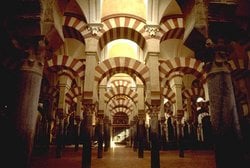
Central dome mosques were introduced by the Ottomans in the fifteenth century and have a large dome centered over the prayer hall. In addition to having one large dome at the center, there are often times smaller domes that exist off-center over the prayer hall or throughout the rest of the mosque, where prayer is not performed.[36]
Hypostyle mosques have prayer halls that are lined with a forest of columns and supports. One of the most notable hypostyle mosques is the Mezquita in Cordoba, Spain as the building is supported by over 850 columns.[37] The Abbasids and Umayyads were the pioneers of the hypostyle mosque.[38]
Inverted "T" mosques get their name from the shape the iwans, and the courtyard they surround, make. A central courtyard in the inverted "T" mosque is flanked by three iwans on three different sides. One iwan, usually the largest and most central, faces Mecca and thus serves as the prayer hall.[39]
Iwan mosques are most notable for their iwans, which are vaulted spaces that open out on one end. In iwan mosques, one or more iwans face a central courtyard that serves as the prayer hall. The style has been used almost exclusively for mosques in Iran. Today, iwan mosques are not built.[36] The Shah Mosque in Isfahan, Iran is a classic example of an iwan mosque.
Rules and etiquette
Mosques, in accordance with Islamic practices, institute a number of rules that are intended to keep Muslims focused on worshipping Allah. While there are several rules, such as those regarding allowing shoes in the prayer hall, that are universal, there are many other rules that are dealt with and enforced in a variety of ways from mosque to mosque.
Cleanliness
All mosques have rules regarding cleanliness as it is an essential part of the worshipper's experience. Muslims before prayer are required to cleanse themselves in a process known as wudu. However, even to those who enter the prayer hall of a mosque without the intention of praying, there are still rules that apply. Shoes are not allowed to be worn inside the carpeted prayer hall. Some mosques will also extend that rule to include other parts of the facility even if those other locations are not devoted to prayer. Congregants and visitors to mosques are supposed to be clean themselves. It is undesirable to come to the mosque after eating something smelly or without being properly bathed.[40]
Dress
Islam requires that its adherents wear clothes that portray modesty. As a result, although many mosques will not enforce violations, both men and women when attending a mosque must adhere to these guidelines. Men are supposed to come to the mosque wearing loose and clean clothes that don't reveal the shape of the body. Likewise, it is recommended that Muslim women wear loose clothing and shirts and pants that cover to the wrists and ankles. Many mosques will require that non-Muslim female visitors also wear a scarf to cover the head in the style of the Islamic hijab. Middle eastern clothing often associated with Islam is not necessary, although many Muslims, regardless of their ethnic background, will wear them to events and prayers at mosques.[2]
Concentration
As mosques are places of worship, those within the mosque are required to remain respectful to those in prayer. Loud talking within the mosque, as well as discussion of topics deemed disrespectful, is forbidden in areas where people are praying. In addition, it is disrespectful to walk in front of or touch Muslims in prayer as it may break the worshipper's concentration.[40] The walls within the mosque have few items, expect for possibly Arabic calligraphy, so Muslims in prayer are not distracted. Muslims are also discouraged from wearing clothing with distracting images and symbols so as not to divert the attention of those standing behind them during prayer.
Gender separation
Mosques around the world deal with gender separation in various ways.
One notable restriction common among nearly every mosque is that against women leading prayer. Although some hadith state that women are allowed to lead prayer in front of all-female congregations, mosques almost always have more men than women present during prayer. Recently, in China, women have been allowed to lead prayer in front of all-female congregations.[41] When it comes to leading prayer in front of mixed-gender congregations, Islam clearly states that only men are allowed to lead prayer. However, there have been a few women, most notably Amina Wadud, who have defied the ruling and have opted to lead mixed-gender prayers and Friday prayers.[42]
Islamic law has no rule asserting that men and women must be separated by a partition in the prayer hall. Ideally, the men are to occupy the lines in front of the women.[43] Nevertheless, many mosques today will put the women behind a barrier or partition or in another room altogether so they are unable to see the imam. The basis of the gender separation within the prayer hall is to help congregants concentrate on worshipping Allah. Mosques in South and Southeast Asia put men and women in separate rooms, as the divisions were built into them centuries ago. American and European mosques do not normally have these divisions built in as they are more often buildings converted from other purposes. The large crowds present at the Masjid al-Haram in Mecca, especially during the annual pilgrimage, often result in unintended mixing between genders.[44] Nevertheless, there are still mosque officials who attempt to enforce the division in some areas.
The same restrictions present in the prayer hall also extend to social events. Men and women at dinners and religious events will often be separated to comply with the Islamic principles that reduce intermingling of the sexes.
Non-Muslims in mosques
Many who advocate preventing non-Muslims from entering mosques cite a verse from Islam's holiest book, the Qur'an, in which pagans are banished from the Sacred Mosque, the Masjid al-Haram in Mecca:
- O ye who believe! Truly the Pagans are unclean; so let them not, after this year of theirs, approach the Sacred Mosque. And if ye fear poverty, soon will Allah enrich you, if He wills, out of His bounty, for Allah is All-knowing, All-wise. (9:28, Yusuf Ali)[45]
That prohibition has since been extended to include all non-Muslims; today the Masjid al-Haram and all of Mecca are open only to Muslims. Likewise, the Masjid al-Nabawi and the city of Medina, Saudi Arabia that surrounds it are also off-limits to those who do not practice Islam.[46] But when it comes to whether non-Muslims should be banned at other mosques, the ruling varies. It has most commonly been taken that non-Muslims may only enter mosques if granted permission to do so by Muslims and if they have a legitimate reason. All entrants regardless of religious affiliation are expected to respect the rules and decorum for mosques.[2]
Despite the provisions allowing non-Muslims to enter mosques, there is still a difference in opinion, even in countries where Muslims are the majority, over whether non-Muslims should be permitted to enter. The Hassan II Mosque in Casablanca, for instance, remains the only mosque in Morocco open to non-Muslims.[47] However, mosques in Turkey are open to everyone.
Saudi influence in foreign mosques
- See also: Wahhabism
Although the Saudi movement to promote its form of Islam around the world can be traced back to the 1960s, it was not until later in the twentieth century that the government of Saudi Arabia began to become a large influence in foreign mosques.[48] Beginning in the 1980s, shortly after the Iranian Revolution, the Saudi Arabian government began to finance the construction of mosques in countries around the world. An estimated US$45 billion has been spent by the Saudi Arabian government financing mosques and Islamic schools in foreign countries. Ain al-Yaqeen, a Saudi newspaper, reported in 2002 that Saudi funds may have contributed to building as many as 1,500 mosques and 2,000 other Islamic centers in countries were Muslims are not the majority.[49] Saudi Arabia practices a form of Islam known as Wahhabism that promotes a strict adherence to Islamic law or Shari'a. As a result, many countries were funding from Saudi Arabia is going to Islamic centers believe Saudi Arabia is exporting extreme fundamentalist views. Since the September 11, 2001 terrorist attacks, countries have also paid more attention to Saudi funding as they fear part of the funding may be going to terrorist groups through foreign mosques.[49]
The effects of this Saudi influence are not easily calculable, but a 2000 American survey suggests that approximately seventy percent of Muslim leaders in the United States favor a fundamentalist approach to Islam and that twenty-one percent of Muslim leaders in the United States favor and practice Wahhabism.[48] The same study also indicated that presence of isolation and separation of women within mosques had begun during the 1980s, around the time Saudi Arabia began to finance foreign mosques, and increased during the 1990s. Whereas in 1994 only about fifty percent of American mosques separated men and women, by 2000 approximately sixty-six percent of American mosques had adopted a separation along gender lines. American mosques have also begun to enforce more modest clothing, even for non-Muslims.[48]
Today, an estimated sixteen mosques in the United States have been built with funds from the Saudi Arabian government. The King Faud Mosque in Culver City, California represents the largest Islamic center built by the kingdom as it was financed by US$8 million in donations from the former Saudi king Fahd bin Abdul Aziz al-Saud whose name is attached to mosque as well as his half-brother, former crown prince, and current king, Abdullah bin Abdulaziz al-Saud.[48] In Europe, one of the largest mosques financed by the Saudi government is the Islamic Cultural Center of Italy, located in Rome, a city normally associated with the Roman Catholic Church. Originally conceived during the 1970s and completed during the early 1980s, over half of the original US$20 million needed to pay for the mosque came from Saudi Arabia and governments from other countries where Muslims are the majority.[50] More recently, former Saudi king Fahd bin Abdul Aziz has contributed over US$50 million to the mosque.[51]
Saudi citizens have also contributed significantly to mosques in the Islamic world, especially in countries where they see Muslims as poor and oppressed. Following the fall of the Soviet Union, in 1992, mosques in impoverished Afghanistan saw many contributions from Saudi citizens. Likewise, al Haramain, a Saudi charity, spends US$40 million to US$60 million annually on mosques, copies of the Qur'an, and other Islamic needs in fifty countries, including many poor countries, around the world.[48]
See also
- Islamic architecture
- Islamic art
- Salah
- Timeline of Islamic history
Notable mosques
- Masjid al-Haram; Mecca, Saudi Arabia - holiest site in Islam[52]
- Masjid al-Nabawi; Medina, Saudi Arabia - second-holiest site in Islam[53]
- Al-Aqsa Mosque; Jerusalem, Israel - third-holiest site in Islam[54]
- Imam Ali Mosque; Najaf, Iraq - holy site in Shi'a Islam
- Faisal Mosque; Islamabad, Pakistan - largest mosque in the world, in area[55]
- Badshahi Masjid; Lahore, Pakistan - large Mughul empire mosque
- Mezquita; Cordoba, Spain - tenth century Moorish place of worship, now a Roman Catholic cathedral
- Hagia Sophia; Istanbul, Turkey - former cathedral; mosque from 1453 to 1935[56]
- Sultan Ahmed Mosque (Blue Mosque); Istanbul, Turkey - built across from the Hagia Sophia
- Shah Mosque; Isfahan, Iran - Iranian mosque commissioned by Shah Abbas I
- Jama Masjid; Delhi, India - one of the largest mosques in India[57]
Notes and references
| Part of the series on History of Islam |
| Beliefs and practices |
|
Oneness of God |
| Major figures |
|
Muhammad |
| Texts & law |
|
Qur'an · Hadith · Sharia |
| Branches of Islam |
| Sociopolitical aspects |
|
Art · Architecture |
| See also |
|
Vocabulary of Islam |
- ↑ Harper, Douglas. Mosque. Online Etymology Dictionary. Retrieved 2006-04-16.
- ↑ 2.00 2.01 2.02 2.03 2.04 2.05 2.06 2.07 2.08 2.09 2.10 Maqsood, Ruqaiyyah Waris (2003-04-22). Teach Yourself Islam, 2nd edition, Chicago: McGraw-Hill, 57-8, 72-5, 112-120. ISBN 0-07-141963-2.
- ↑ The Islamic World to 1600: The Arts, Learning, and Knowledge (Architecture). The University of Calgary. Retrieved 2006-04-12.
- ↑ Kuban, Dogan (August 1974). "The Mosque", Muslim Religious Architecture: Muslim Religious Architecture. Brill Academic Publishers, 1. ISBN 9004038132.
- ↑ Holy Mosque in Makkah. Ministry of Hajj - Kingdom of Saudi Arabia. Retrieved 2006-04-06.
- ↑ Masjid Quba'. Ministry of Hajj - Kingdom of Saudi Arabia. Retrieved 2006-04-15.
- ↑ 7.0 7.1 Ghali, Mohammad. "The First Muslim State", The Prophet Mohammad and the First Muslim State. Retrieved 2006-04-07.
- ↑ The Ottoman: Origins. Washington State University. Retrieved 2006-04-15.
- ↑ Al-Fustat. The University of Texas at Austin. Retrieved 2006-04-16.
- ↑ Budge, E.A. Wallis (2001-06-13). Budge's Egypt: A Classic 19th-Century Travel Guide. Courier Dover Publications, 123-128. ISBN 0486417212.
- ↑ Theoretical Issues of Islamic Architecture. Foundation for Science Technology and Civilisation. Retrieved 2006-04-07.
- ↑ Cowen, Jill S., "Muslims in China: The Mosque", Saudi Aramco World, July/August 1985, pp. 30-35. Retrieved 2006-04-08.
- ↑ Gesink, Indira J. Falk. Mughal Architecture. Baldwin-Wallace College. Retrieved 2006-04-15.
- ↑ Mosques. Charlotte Country Day School. Retrieved 2006-04-07.
- ↑ Lawton, John, "Muslims in Europe: The Mosque", January/February 1979, pp. 9-14. Retrieved 2006-04-17.
- ↑ The Mosque in America:A National Portrait. Council on American-Islamic Relations. Retrieved 2006-04-07.
- ↑ Abouei, Reza. Urban Planning of Isfahan in the Seventeenth Century. University of Sheffield School of Architecture. Retrieved 2006-04-07.
- ↑ Madanipour, Ali (2003-05-09). Public and Private Spaces of the City. Routledge, 207. ISBN 0415256291.
- ↑ Abdo, Geneive (September 2005). Islam in America: Separate but Unequal. The Washington Quarterly 28 (4): 7-17.
- ↑ Carolyn's Corner: Words Related to World Religions. Scripps National Spelling Bee. Retrieved 2006-04-06.
- ↑ Prayer in Congregation. Compendium of Muslim Texts. University of Southern California. Retrieved 2006-04-06.
- ↑ Fiqh-us-Sunnah, Volume 4: Funeral Prayers (Salatul Janazah). Compendium of Muslim Texts. University of Southern California. Retrieved 2006-04-16.
- ↑ Eclipses. Compendium of Muslim Texts. University of Southern California. Retrieved 2006-04-16.
- ↑ 'Id Prayers (Salatul 'Idain). Compendium of Muslim Texts. University of Southern California. Retrieved 2006-04-08.
- ↑ Charity. Compendium of Muslim Texts. University of Southern California. Retrieved 2006-04-17.
- ↑ Primary Concepts : Eids. Media Guide to Islam. San Francisco State University. Retrieved 2006-04-15.
- ↑ Wheeler, Brannon M. (2002-08-01). "Preface", Teaching Islam. Oxford University Press US, v. ISBN 0195152255. “and [Islam] remains the fastest growing religion both in the United States and worldwide”
- ↑ Walters, Brian (2004-05-17). "The Prophet's People", Call to Prayer: My Travels in Spain, Portugal and Morocco. Virtualbookworm Publishing, 14. ISBN 1589395921. “Its 210-meter minaret is the tallest in the world”
- ↑ Umayyad Grandeur: First Imperial Expressions. OpenCourseWare. Massachusetts Institute of Technology. Retrieved 2006-04-16.
- ↑ Mainzer, Klaus (1996-06-01). "Art and Architecture", Symmetries of Nature: A Handbook for Philosophy of Nature and Science, 124. ISBN 3110129906. “the dome arching over the believers like the spherical dome of the sky”
- ↑ Asher, Catherine B. (1992-09-24). "Aurangzeb and the Islamization of the Mughal style", Architecture of Mughal India. Cambridge University Press, 256. ISBN 0521267285.
- ↑ Religious Architecture and Islamic Cultures. Massachusetts Institute of Technology. Retrieved 2006-04-09.
- ↑ 33.0 33.1 Mosque FAQ. The University of Tulsa. Retrieved 2006-04-09.
- ↑ Bierman, Irene A. (1998-12-16). Writing Signs: Fatimid Public Text. University of California Press, 150. ISBN 0520208021.
- ↑ Terms 1: Mosque. University of Tokyo Institute of Oriental Culture. Retrieved 2006-04-09.
- ↑ 36.0 36.1 Vocabulary of Islamic Architecture. Massachusetts Institute of Technology. Retrieved 2006-04-09.
- ↑ Mihrab within the Mezquita in Córdoba, Spain. Glendale Community College. Retrieved 2006-04-15.
- ↑ Great Mosque of Córdoba. ArchNet. Massachusetts Institute of Technology. Retrieved 2006-04-09.
- ↑ Peker, Ali Uzay. Mevlana Celaleddin-i Rumi. Middle East Technical University. Retrieved 2006-04-16.
- ↑ 40.0 40.1 Etiquettes in the Mosque. Ahmadiyya Muslim Community. Retrieved 2006-04-15.
- ↑ Lim, Louisa, "Chinese Muslims forge isolated path", BBC News, 2004-09-15. Retrieved 2006-04-07.
- ↑ "Woman leads US Muslims to prayer", BBC News, 2005-03-15. Retrieved 2006-04-09.
- ↑ Doi, Abdur Rahman I.. Women in Society. Compendium of Muslim Texts. University of Southern California. Retrieved 2006-04-15.
- ↑ Rezk, Rawya, "Muslim Women Seek More Equitable Role in Mosques", The Columbia Journalist, 2006-01-26. Retrieved 2006-04-09.
- ↑ Interpretation of the Meanings of The Noble Qur'an. Trans. Abdullah Yusuf Ali. Riyadh, Saudi Arabia: n.p., n.d.
- ↑ Goring, Rosemary (1997-05-01). Dictionary of Beliefs & Religions. Wordsworth Editions. ISBN 1853263540.
- ↑ Morocco: Culture and Society. School for International Training. Retrieved 2006-04-16.
- ↑ 48.0 48.1 48.2 48.3 48.4 Ottoway, David B., "U.S. Eyes Money Trails of Saudi-Backed Charities", The Washington Post, 2004-08-19, p. A1. Retrieved 2006-04-17.
- ↑ 49.0 49.1 Kaplan, David E., "The Saudi Connection", U.S. News and World Report, 2003-12-15. Retrieved 2006-04-17.
- ↑ Scarfiotti, Gian Luigi, "A Mosque for Rome", September/October 1978. Retrieved 2006-04-17.
- ↑ Islamic Center in Rome, Italy. King Fahd bin Abdul Aziz. Retrieved 2006-04-17.
- ↑ Miller, Pamela, "Journey of a lifetime", Star Tribune, 2006-01-07, p. 12E.
- ↑ Abu-Nasr, Donna, "Many Saudis criticize attack", Ventura County Star, 2004-12-09, p. 16.
- ↑ "Arafat to be buried in soil from Islam's third holiest site", Associated Press, 2004-11-11.
- ↑ Press Release: First in Pakistan. Embassy of Pakistan, Washington, D.C.. Retrieved 2006-04-10.
- ↑ Building Big: Databank: Hagia Sophia. PBS. Retrieved 2006-04-10.
- ↑ Lach, Donald F., and Edwin J. Van Kley (1998-12-01). "The Empire of Aurangzib", Asia in the Making of Europe:. University of Chicago Press, 721. ISBN 0226467678. “The Jami Masjid, the largest mosque in India”
External links
- Ottoman: Art and the Culture - provides information on Ottoman mosques and architecture
- Flickr: Mosques and Minarets - a compendium of over two thousand photos of mosques around the world
- The Mosque Review (Masjid) - provides an overview of the features and floor plans of mosques
ar:مسجد bg:Джамия ca:Mesquita cs:Mešita da:Moske de:Moschee et:Mošee es:Mezquita eo:Moskeo fa:مسجد fr:Mosquée id:Masjid is:Moska it:Moschea he:מסגד jv:Mesjid lt:Mečetė hu:Mecset ms:Masjid nl:Moskee ja:モスク no:Moské nn:Moské os:Мæзджыт pl:Meczet pt:Mesquita (templo islâmico) ru:Мечеть simple:Mosque sl:Mošeja sr:Џамија fi:Moskeija sv:Moské th:มัสยิด tr:Cami (ibadethane) zh:清真寺
Credits
New World Encyclopedia writers and editors rewrote and completed the Wikipedia article in accordance with New World Encyclopedia standards. This article abides by terms of the Creative Commons CC-by-sa 3.0 License (CC-by-sa), which may be used and disseminated with proper attribution. Credit is due under the terms of this license that can reference both the New World Encyclopedia contributors and the selfless volunteer contributors of the Wikimedia Foundation. To cite this article click here for a list of acceptable citing formats.The history of earlier contributions by wikipedians is accessible to researchers here:
The history of this article since it was imported to New World Encyclopedia:
Note: Some restrictions may apply to use of individual images which are separately licensed.
